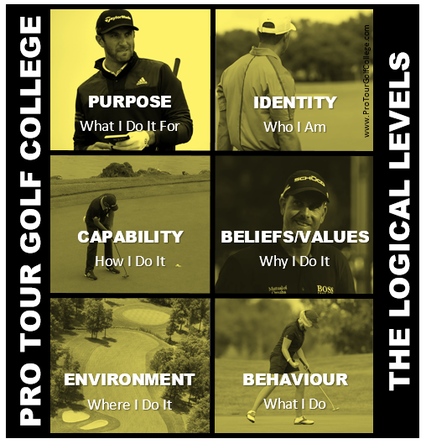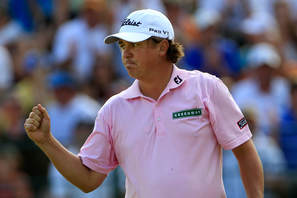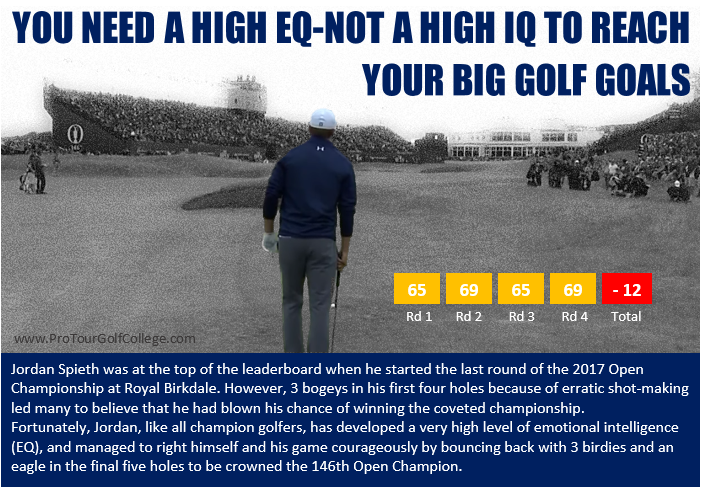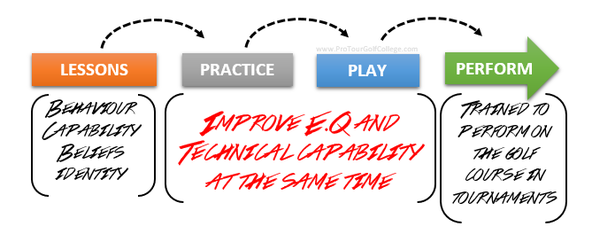|
The goal programming process we use in our training programs at Pro Tour Golf College define the core training factors in our E.I. training process and were developed based on The Logical Levels of Change model created by Robert Dilts, an organisational psychologist and one of the early developers, authors, and trainers in the field of Neuro-Linguistic Programming (NLP).  The Logical Levels of Change Model The “Logical Levels of Change” model is based on Dilts extensive research into change and organisational learning and was influenced and adapted from the work of Anthropologist Dr Gregory Bateson, and it has many different applications. We use The Logical Levels of Change model to guide our students in identifying the factors that promote—or even limit their goal effectiveness. The Logical Level’s model describes six levels, with each level helping our students to understand the link between what they think, what they do, and the results they achieve, on and off the golf course. Where I Do What I Do The base level is the Environment level, which describes location, or where you are, and what’s around you. One of the key questions we ask students at this level is; “how does where you are, including the content of the environment, affect what you do?” What I Do, and Where I Do it This environment question leads them into the next level of the model, the Behavior level, which describes what our students do, or how they act in the environment they train—or perform in. How I Do What I Do, and Where I Do it The next level is the Capability level. Now, if Behavior is the act of performing, then the capability level is the level where they know (or don’t know) how to do what they do. This is the ‘how to’ level of behavior in the environment they train or perform in. Why I Do What I Do, and Where, and How I Do it After this level comes the Beliefs and Values level. As you will see, Values drive our purpose. Values define the ‘what’s important to me in my golf?’ questions. Beliefs, on the other hand, describe what a student believes to be true about them-self, and also what they believe they are capable of doing, and what they believe about other people and their beliefs. Who I Am, Why I Do What I Do, and Where, and How I Do it The next level is the level of Identity. This describes the ‘I’ part of you, or who you believe you are—your sense of self. Identity relates to your self-image, the mental model you have of yourself, your self-esteem, and your individuality. The Overarching Purpose That Explains How I Know Who I Am, Why I Do What I Do, and Where, and How I Do it The final level is the level of Purpose or Spirit. This is the level where you recognize that you are a part of something much greater than yourself, it could be to achieve your greatest golfing goal, such as a goal that would define you and your life, or something much more significant to you, something you feel deeply connected to, and something that you could dedicate your whole life to. Some great questions are created using The Logical Levels of Change model, and these questions help our students to gain the clarity to start designing their goals. The following questions are examples of the type of questions that cover The Where, What, How, Why and Who of the goal programming process. Take the time to write these question down and answer them. It will help you to develop the clarity you need to design your goals.
The Goal Formula That Defines Your What, So You Can Design the How, Based on Your Why Well-formed questions help students define specifically what they want, so they can develop the strategies and tools necessary for performing closer to their expectations.  The goal formula above helps our students to understand the critical to performance factor that bridges the gap between their goal or intention, and the action they take. We prefer to describe goal setting as goal programming because we see the achievement of goals as a mental conditioning or programming process, and as such we use a simple three-step process; 1. Define what it is you want from your golf (The What) 2. Design the process for achieving what you want (The How) 3. Dedicate yourself to achieving what you want (The Why) The goal programming formula defines the master key to achieving your goals within the goal process, because every golfer has a dream of improving their game to a certain standard, but it seems that few ever turn the dream into the skills or game they really want. A well-designed goal process takes your dream, applies a set of specific action steps that eventually makes it real. So, for your behavior to be consistent enough to experience the Achievement, or accomplishment of your goal, the formula requires that you employ a high degree of Dedication, or persistent effort. No surprises there, right? Notice that the formula has an input end... D = Dedication, and an output end... A = Achievement? This describes two of the known elements in a goal process—inputs and outputs. But what it doesn’t tell us is the source of where the motivation to keep the inputs continually coming in originates from... We know that many golfers who start out on the journey to golf improvement, give up along the way, but the serious one’s stick with it for the longest time. These golfers usually take consistent lessons from the same golf teacher over many years, and apply long hours of effort on the practice range primarily because they are clear on what they need to improve. They don't hope to see improvement in their game, they know it will happen. The most common development pathway used by golfers is described in the image below. You take a series of lessons, you practice and play, and you hope that this leads you to performing better on the golf course. Many golfers the world over follow a process that looks just like this, so why then do so few perform better on the golf course? Well, in most cases they lose their motivation, through frustration of slow to no improvement, or because of consistent disappointment and set-backs, all of which has them giving up long before their goal of performing to their expectations is realized? We know how important Dedication is for Achieving goals. Yet, for the Dedication to be consistent, The Goal Value or what we call the heart of the goal, must be high enough, and also relevant to your needs. The bottom line is that you will never maintain the motivation to Achieve your goal if you don’t Value the goal (the what) highly, and you will never improve your performance on the golf course if you practice skills that are not pertinent to your needs (the why). Why is Golf Instruction Stuck at the Capability Level? Another reason why golfers don’t achieve their goals is because most golf teachers focus mainly on the Capability level of change? Yep, golf technique skills mostly, which doesn’t make much sense when you consider that golf is a multi-dimensional game… In other words, golf has many facets that have to be polished to become a complete player. So, for example, a golfer might want to improve a particular stroke pattern, and so the teacher dutifully goes to work altering or modifying it. Great! The golf stroke pattern is improved, so why does the student still play poorly on the golf course? Based on the Logical Levels Model the student is trying to improve many aspects of the game by improving just one level--capability. So the question becomes; when will the student learn how to build a supporting belief system that allows him/her to transition from practicing to playing/performing on the golf course? The Flawed Golf Improvement Model Let’s say that they can perform their stroke pattern successfully a high percentage of the time, but what happens when they hit one—two or more bad shots? Their behavior takes a turn for the worse because there was no safety net installed for the inevitable break-downs that occur in every golfer’s game. This scenario is typical, and extremely common at all levels. The amount of times we have seen a good golfer behaving in a textbook fashion until a few bad shots derail their confidence and composure is very common. You may know of golfers who have taken a series of golf lessons, or even attended a golf school, and in the beginning, there was a noticeable change in their skill (and behavior), but over time they reverted to their old and familiar ways. The Improved Golf Improvement Model The emotionally intelligent golfer understands that golf instruction without parallel development of E.I. training factors such as Behavior, Beliefs and Values, and Identity is a flawed development model that will not lead to playing closer to expectations on the golf course. Golfers who want to play better on the golf course, particularly when it matters most need additional tools in their tool box and that's precisely where E.Q training comes in.  Golfers in our experience who invest most of their time improving their golf swing and shot-making skills, but never get exposed to E.I. training, which exists beyond the capability level, are setting themselves up for certain frustration and disappointment. In our final article in this series (part 5), we will cover the final part of our Emotional Intelligence program including our O.P.B. model, the C.H.E.N mental toughness training drills, and our formula for designing a productive golf training environment. See you next month. Lawrie Montague and David Milne - Pro Tour Golf College Comments are closed.
|
Archives
June 2019
|
Proudly Supported By
Copyright © 2011 - 2018 Pro Tour Golf College
Website Managed By Golf Performance Media
All Rights Reserved
Website Managed By Golf Performance Media
All Rights Reserved









 RSS Feed
RSS Feed



